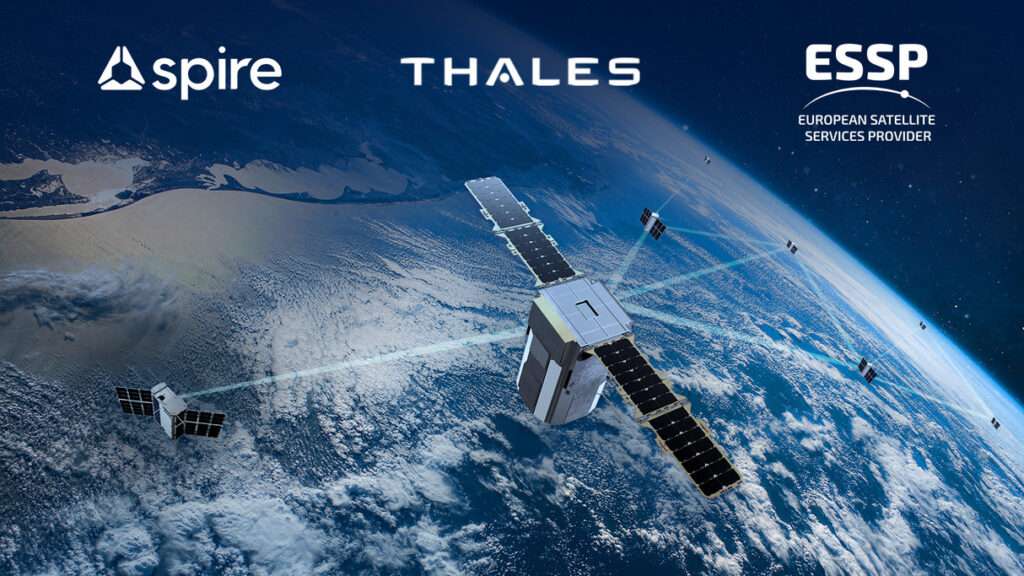A proposed new 100+ satellite constellation will provide real-time air traffic management and surveillance, enhancing aviation safety, sustainability and airspace security.
Three companies are joining forces to develop a satellite constellation and offer new space-based surveillance services for Air Navigation Service Providers.
Thales (Euronext Paris: HO), Spire Global (NYSE: SPIR), and European Satellite Services Provider (ESSP) have now signed a Memorandum of Cooperation to revolutionize air traffic management (ATM).
This innovative solution aims to address critical industry challenges, enhance safety, and pave the way for a more sustainable future of aviation.
Real-Time Tracking with a Dedicated Constellation
The project centers around a specialized network of over 100 satellites designed to collect Automatic Dependent Surveillance-Broadcast (ADS-B) messages directly from aircraft.
Spire, a leader in the New Space sector, will spearhead the space segment, encompassing system design, satellite and payload construction, ground control, and data collection.
Thales, a longstanding leader in ATM solutions, will contribute its expertise in ground-based air traffic management systems and service supervision infrastructure.
ESSP, a certified space-based Navigation and Communication service provider, will manage service certification and delivery for air traffic surveillance.
It will ensure 24/7 operations that meet real-time, safety-critical air traffic control (ATC) requirements.

Proposed 2027 Launch
The partnership builds on the strengths of the Space Alliance formed by Thales Alenia Space and Telespazio.
This collaboration will unlock valuable synergies in key enabling technologies, secure network optimization, and sustainable operations.
The group aims to achieve service certification, commercialization, and launch by 2027.
Stakeholder Comments
Industry leaders from each company spoke with enthusiasm about the project’s potential to transform aviation.
“This is a ground breaking development,” says Philip Plantholt, Spire’s General Manager of Aviation. “We are poised to offer the first real alternative to aging systems. We will embark on a future of even more advanced space based solutions.”
Christian Rivierre, Thales’s vice president of Airspace Mobility Solutions, gave further comment. “This service will accelerate the implementation of our ‘Air Traffic Control as a Service’ offering.”
“It will play a crucial role in shaping the future of the skies, enabling trajectory-based operations. It will also provide a safer, greener, and more cost-effective ATM system.”
Charlotte Neyret, ESSP’s CEO, spoke of the importance of the initiative: “This is a game-changer for aviation.”
“Our user-driven service addresses the challenges of digitization, greener travel, and next-generation service levels.”

Addressing Critical ATC Needs
The aviation industry faces increased pressure to prioritize safety, security, and environmental impact.
Traditional ATM systems struggle to keep pace with these demands. They lack the high performance, scalability, and economic viability required for the modern airspace.
This initiative brings together the strengths of each partner:
- Thales: Over 50 years of experience in ground based surveillance and the space heritage of Thales Alenia Space.
- Spire: A leader in New Space technology with expertise in ADS-B payloads.
- ESSP: Proven expertise as a certified space based Navigation and Communication service provider.
This combined expertise positions the group to perfectly to tackle ambitious goals and deliver a future-proof solution.
The new end-to-end system will be tested to meet the demanding latency and coverage, and revisit time standards. These are set by the International Civil Aviation Organization (ICAO) and aviation authorities for air traffic surveillance certification.
The constellation’s design ensures continuous technology upgrades through regular satellite replacements every five years.
This evolutionary approach guarantees that users always benefit from the latest advancements.

Beyond ADS-B: Exploring Next-Generation Tracking
In parallel to building the initial constellation, the companies are developing a groundbreaking system that goes beyond ADS-B.
This novel solution aims to track aircraft in real time without relying on GNSS/GPS satellites. It thus offers a resilience against potential vulnerabilities like interference or outages.
A successful demonstration paves the way for a highly resilient, second-generation service. This future offering will open doors for holistic infrastructure optimization strategies for Air Navigation Service Providers (ANSPs) by the end of the decade.
This collaboration signifies a significant leap forward in air traffic management. It leverages cutting-edge satellite technology and industry-leading expertise. By so doing, the consortium is poised to deliver a safer, more sustainable, and efficient future for aviation.

Click the banner to subscribe to our weekly newsleter.

Click the photo to join our WhatsApp channel so then you can stay up to date with everything going on in the aviation industry!







